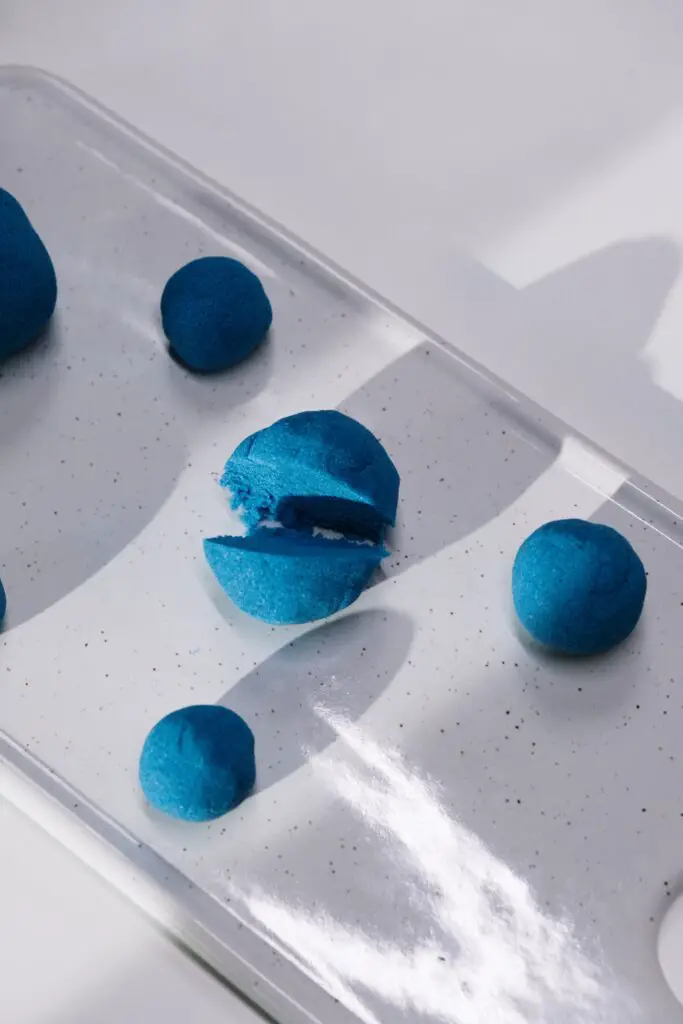Bring out your inner artisan with clay! Working with Sculpey polymer clay is a fun way to create unique and eye-catching jewelry, miniatures, decorations, and art pieces. Whether you are new to the world of sculpting or just looking for a new outlet for your creativity, learning how to soften this popular type of modeling clay efficiently can make crafting easier–and more enjoyable. This blog post will take an in-depth look at exactly what Sculpey polymer clay is. Also, we’ll look at how to properly soften Sculpey polymer clay before molding and forming whatever creation comes to mind.
What is Sculpey Polymer Clay?
Sculpey polymer clay is a type of polymer clay for creating crafts and art projects. It comes in many colors, including white, black, and bright colors like blue and pink. It can make jewelry, charms, sculptures, figurines, decorative objects, and more. Sculpey clay is soft when worked with your hands but hardens when heated in the oven. The finished pieces are durable and waterproof.
Sculpey polymer clay is excellent for both beginners and experienced crafters alike. It is easy to work with and doesn’t require any special tools or skills. You can shape it by hand or use molds to create intricate designs. It also accepts paints well so that you can customize your creations with vibrant colors. If you need a break from your project, you don’t have to worry about it drying out – wrap the remaining clay in plastic wrap to keep it moist until next time!
Sculpey polymer clay has been around for over forty years. There are plenty of resources are available if you need further information. In addition, there are tons of tutorials online and books filled with ideas for projects that will inspire your creativity.
Popular Uses for Sculpey Clay
Sculpey polymer clay is one of the most versatile mediums for crafting, and it’s easy to see why. This material’s possibilities are nearly limitless, as it can be used in various applications, from creating jewelry to making sculptures. So whether you’re an experienced crafter or just starting out, there’s something here for everyone.
One popular use of Sculpey clay is creating jewelry. Easy to mold and shape, the clay can be easily formed into pendants, earrings, rings, and other types of jewelry. You can even add color or texture by mixing in other elements like glitter or paint for a unique look. Sculpey clay also holds its shape over time, so your creations will last longer than other jewelry materials.
Another great use for Sculpey clay is sculpture-making. This medium allows you to create incredibly detailed sculptures that would otherwise be impossible with traditional sculpting methods. With its ability to hold its shape while still being malleable and easy to work with, it’s perfect for crafting larger pieces like animals or figures that require more precision than a simple block of stone would provide. Best of all, you can bake the finished pieces in an oven at 275 degrees Fahrenheit to harden the clay and make it permanent once you’re done sculpting!
Finally, Sculpey clay can also be used for smaller projects like charms and decorations for holidays or special occasions. It’s easy to create 3D objects with intricate details without having any experience with sculpting or complex tools. Anyone could make unique-looking charms and trinkets out of this material! Plus, if you don’t have an oven handy, air-drying clays allow you to harden your creation without needing additional heat sources – perfect if you’re on the go!
Understanding How to Soften Sculpey Clay
When working with Sculpey clay, one of the most important things to know is how to soften the material so that it can be more easy to work with. Softening the clay allows for easier manipulation, so sculptures, jewelry, and other items created from the clay can be as accurate and detailed as possible.

The good news is that to soften Sculpey polymer clay is a relatively straightforward process. To begin with, you’ll need to knead the clay until it has reached room temperature. This will make the material softer and more malleable. It’s important to note that if you overheat the clay, it can become brittle and difficult to work with. Once you have softened the clay by kneading it, you’re ready to shape it into whatever project you’re creating.
If you’re having trouble softening Sculpey clay, several other methods can be used. One option is to place a damp cloth over the material and allow it to absorb moisture; this will help soften the clay without making it too hot or brittle. Another method is using a simple household hairdryer on low heat; be sure not to leave the hairdryer too close or pointed directly at the surface of the clay for too long. Finally, submerging your Sculpey in warm water for an hour or two should do the trick if all else fails!
Six Different Methods on How to Soften Sculpey Clay
Sculpey polymer clay is a popular material for crafters, sculptors, and hobbyists who enjoy working with clay. Its firm texture and strong hold make it ideal for creating detailed sculptures and other objects. However, the same quality that makes it so useful can also make it challenging to work with since it tends to be quite hard when first opened from the package. Fortunately, several methods can be used to soften Sculpey polymer clay and make it easier to shape, sculpt, and mold. Here are six different techniques for softening Sculpey clay:
1. Using Heat to Soften Sculpey Polymer Clay
A common way of softening Sculpey clay is by applying heat directly. This can be done by placing the clay pieces into an oven preheated to 275°F (135°C). You can also use a heat gun set on low temperature. Make sure you keep an eye on the clay while heating as it will become soft quickly. If it’s left in too long, it will become too soft and mushy. Once the desired consistency has been achieved, remove the clay from the heat source. Then, let it cool before handling or shaping.
2. Steaming to Soften Sculpey Clay
Steam application is another way to soften Sculpey clay. Boil a pot of water on your stovetop or use a handheld steamer. Then place pieces of Sculpey onto a metal baking tray before carefully holding them over the steam for 10-15 seconds at a time until they have softened enough to handle comfortably without squashing flat. When it’s finished, let cool completely before continuing your project.
3. Soften Sculpey Clay Using the Kneading Method
You can also soften Sculpey clay by kneading it with your hands or a rolling pin. Be sure to roll out evenly, as this may prevent your sculpture from losing its shape once cooled down afterward! The warmth from your hands helps condition the clay particles together while kneading, which in turn helps soften them up nicely.

4. Soaking Method
A less commonly known method to soften Sculpey polymer clay is soaking – place pieces of clay in room temperature water for around 30 minutes, then take them out and let dry off before using as normal! This technique works great, especially if you don’t want to risk over-cooking your sculptures in an oven or worry about getting burned from steam during the application process! Plus – no need for additional tools either!
5. Conditioner Method
Special conditioners are specifically designed to soften hard polymer clays such as Sculpey – these are particularly beneficial when working with very stiff clays as they help reduce brittleness significantly, making them much easier to manipulate than before use! Apply small amounts directly onto the surface area needing softer consistency, then knead accordingly until desired results have been achieved – easy peasy!
6. Adding Oil to Soften Sculpey Polymer Clay
Finally – adding oil into the mixture when working with hardened clays can also prove effective at increasing malleability levels without worrying about over-cooking outer layers like before using the heat method previously mentioned earlier! Add a couple of drops of vegetable/olive oil (or baby oil) into the mix, then stir properly until combined evenly throughout the mix – voila – you now have perfect consistency ready for modeling without fuss or hassle!
Tips and Tricks for Working with Sculpey Clay
Sculpey clay is an incredibly versatile and easy-to-use material for various art projects. Whether you’re just starting out with clay or working with it for years, there are lots of tips and tricks that can help make your projects easier and more successful. Here are a few of the best tips and tricks for working with Sculpey clay.
1. Work on a dry surface
Clay tends to stick better to dry surfaces like glass or ceramic tiles, so it’s best to keep your workspace as dry as possible. To prevent sticking, you can lightly dust your work area with cornstarch or talc powder.
2. Don’t forget the oven
After you’ve created your masterpiece, be sure to bake it according to the instructions on the package. This will ensure that your sculpture holds its shape and lasts longer.
3. Keep experimenting and have fun
Sculpey clay is a great way to explore your creativity. Try different colors, shapes, sizes, and techniques until you find something that works for you. Remember that there’s no wrong way to work with clay—so don’t be afraid to get creative!

4. Don’t forget about safety when working with Sculpey Clay
Ensure you always wear protective gloves while working with the material and take extra care when baking in the oven as temperatures can reach up to 300°F (150°C). It’s also important not to let children handle Sculpey without adult supervision because small parts could present a choking hazard if swallowed.
Hopefully, these tips will help you get started on creating beautiful sculptures using Sculpey polymer clay! Have fun experimenting, and remember: practice makes perfect!
Choosing the Right Tools and Materials
Quality tools and materials can help you produce high-quality results, while cheaper alternatives may need to be able to stand up to the same level of wear and tear. When selecting your materials, it pays to invest in quality products that will last for years. Investing in quality tools ensures that your projects will look professional when completed. In addition, quality materials are essential if you plan on using the finished item for long-term use or as a gift for someone else.
As for choosing tools and materials for crafting, it is important to know how frequently you plan on using them, what type of projects you do, and what budget you have available. If you are starting out with crafting, buying bare basics such as scissors, glue guns, and paintbrushes is a great start. However, investing in high-quality supplies for more advanced projects will give you better results as they are designed with durability. Professional grade items tend to cost more but are usually worth the extra expense due to their higher performance levels. Additionally, different types of crafts require specific supplies, so it is important to research what supplies are best suited for each type of craft before making any purchases.
Finally, when purchasing supplies, always double-check that they meet safety standards according to local regulations. Also, pay attention to expiration dates, as some crafting items can expire over time, creating potential hazards if used after their expiration date. Doing research online or asking experienced crafters for advice is also a great way to get information about which brands offer safe and reliable products at reasonable prices. With these tips in mind, it should be easier for anyone looking for the right tools and materials needed for crafting success!
Techniques for Shaping the Sculpey Polymer Clay
Clay is an incredibly versatile medium that can create abundant objects, from figures and sculptures to tiles and vessels. Shaping the clay is a key part of these creative endeavors, and several techniques are available for achieving this. The most common method is simply pinching the clay between two fingers or hands to form the desired shape. This technique works well with smaller pieces but can also be used on larger works by forming ridges with the fingers and then smoothing them out by pushing them together.
Another popular method is to use tools such as ribs, knives, or sponges to carve out details or texture onto the surface of the clay. Finally, molds and presses can aid in forming intricate designs or replicating a specific shape multiple times. Although shaping clay is often considered difficult, these techniques make it possible for anyone – no matter their skill level – to craft unique objects from this malleable material.
Safety Considerations when Handling Sculpey Clay
When handling polymer clay, it is important to take safety precautions. Here are the most important safety considerations. First, avoid contact with the skin and eyes, as the particles in the clay can irritate them and cause discomfort. Second, wear a dust mask when sanding or cutting the polymer clay to avoid inhaling any small particles. Third, keep all tools and other items used with the polymer clay away from children, as they can be sharp items that may result in injury if mishandled. Finally, always wash your hands after handling polymer clay to ensure that none of the particles remain on your hands or body.

It is also important to remember that some forms of polymer clay can be toxic if ingested and should be kept out of reach of children at all times. Also, please don’t use food utensils or bakeware intended for food when working with polymer clays, as they must not come into contact with edible materials and surfaces.
While these safety considerations should be considered when handling polymer clays, it is also worth remembering that there is plenty of fun when using these materials! With careful consideration for safety and a bit of practice, you can create beautiful works of art with this unique material!
Benefits of Working with Sculpey Polymer Clay
Working with Sculpey polymer clay presents a range of benefits to crafters, hobbyists, and artists. Since the clay is soft and pliable right out of the package, it is easy to shape into any desired form without having to deal with chipping or cracking. Furthermore, this type of clay is non-toxic and safe to handle without needing additional protective gear or equipment. This makes it an ideal material for use in classrooms and other educational settings.
Additionally, since the clay does not require firing or baking after shaping, it can be molded into complex shapes quickly and easily without needing special tools or techniques. In addition, because the clay does not need to be fired to harden, it can be painted directly on with acrylic paints to create vivid colors and patterns that will last for years. Finally, Sculpey clay is lightweight and durable enough that pieces created from this material can be used as decorations and toys in various settings.
Conclusion on How to Soften Sculpey Clay
In conclusion, Sculpey clay is an excellent option if you are looking for fun way to unleash your inner artist. This versatile medium can be used for a wide range of artistic crafts that allow your creativity and imagination to soar. Sculpey polymer clay is also fairly easy to handle, as long as you know how to properly soften Sculpey polymer clay and use the appropriate tools and materials. The key is to start small and practice, so don’t fret if your first few projects don’t turn out as you had hoped – the more you work with this type of modeling clay, the better you will become at shaping it into your desired creations.
To embark on a creative journey that could take your artwork off the page and into a physical being, I invite you to explore all Sculpey clay offers. As they say, practice makes perfect!
